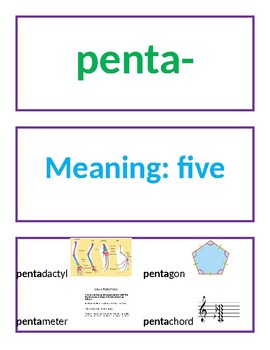Number Roots Match
Teacher Connection
17 Followers
Grade Levels
4th - 8th, Homeschool
Subjects
Resource Type
Standards
CCSS3.MD.A.2
CCSS4.MD.A.1
CCSS4.MD.A.2
CCSS5.MD.A.1
CCSSL.3.4c
Formats Included
- Word Document File
Pages
20 pages
Teacher Connection
17 Followers
Description
Students match 3 cards per set (number word root/prefix, definition, example words with pictures). Concludes with a worksheet where students must refer back to their matching card sets. 18 number roots are included x 3 cards per set = 54 cards:
mono
uni
bi
du
tri
tetra
quad
penta
quin
hex
hept
sept
oct
non
dec
cent
kilo
milli
mono
uni
bi
du
tri
tetra
quad
penta
quin
hex
hept
sept
oct
non
dec
cent
kilo
milli
Total Pages
20 pages
Answer Key
Included
Teaching Duration
45 minutes
Last updated Mar 22nd, 2018
Report this resource to TPT
Reported resources will be reviewed by our team. Report this resource to let us know if this resource violates TPT’s content guidelines.
Standards
to see state-specific standards (only available in the US).
CCSS3.MD.A.2
Measure and estimate liquid volumes and masses of objects using standard units of grams (g), kilograms (kg), and liters (l). Add, subtract, multiply, or divide to solve one-step word problems involving masses or volumes that are given in the same units, e.g., by using drawings (such as a beaker with a measurement scale) to represent the problem.
CCSS4.MD.A.1
Know relative sizes of measurement units within one system of units including km, m, cm; kg, g; lb, oz.; l, ml; hr, min, sec. Within a single system of measurement, express measurements in a larger unit in terms of a smaller unit. Record measurement equivalents in a two-column table. For example, know that 1 ft is 12 times as long as 1 in. Express the length of a 4 ft snake as 48 in. Generate a conversion table for feet and inches listing the number pairs (1, 12), (2, 24), (3, 36),...
CCSS4.MD.A.2
Use the four operations to solve word problems involving distances, intervals of time, liquid volumes, masses of objects, and money, including problems involving simple fractions or decimals, and problems that require expressing measurements given in a larger unit in terms of a smaller unit. Represent measurement quantities using diagrams such as number line diagrams that feature a measurement scale.
CCSS5.MD.A.1
Convert among different-sized standard measurement units within a given measurement system (e.g., convert 5 cm to 0.05 m), and use these conversions in solving multi-step, real world problems.
CCSSL.3.4c
Use a known root word as a clue to the meaning of an unknown word with the same root (e.g., company, companion).




